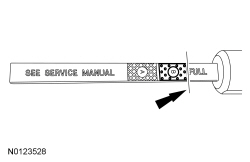
SECTION 307-01: Automatic Transaxle/Transmission — 6R80
| 2014 Mustang Workshop Manual
|
DIAGNOSIS AND TESTING
| Procedure revision date: 01/07/2013
|
 |
Vehicle Communication Module (VCM) and Integrated Diagnostic System (IDS) software with appropriate hardware, or equivalent scan tool
|
| Item | Specification |
|---|---|
| Motorcraft® MERCON® LV Automatic Transmission Fluid
XT-10-QLVC (US); CXT-10-LV12 (Canada) | MERCON® LV |
Check the following items prior to beginning the diagnostic procedures:
Know and Understand the Concern
To correctly diagnose a concern, first understand the customer concern or condition. Customer contact may be required in order to begin to verify the concern. Understand the conditions, including when the concern occurs. For example:
After understanding when and how the concern occurs, proceed to Verification of Condition.
Verification of Condition
Use the information in this section to determine the actual cause of the customer concern to carry out the appropriate procedures.
Use the following procedures when verifying transmission concerns.
Determine Customer Concern
NOTE: Some transmission conditions can cause engine concerns. The torque converter not disengaging may stall the engine.
Determine customer concerns relative to vehicle use and dependent driving conditions, paying attention to the following items:
Check Transmission Fluid Level and Condition
Transmission Fluid Level Check
NOTICE: The vehicle should not be driven if the transmission fluid level is low as internal transmission failure could result.
NOTICE: The transmission fluid fill plug is located near the exhaust system. The exhaust will be extremely hot during this procedure.
NOTE: If the vehicle has been operated for an extended period at high highway speeds, in city traffic or during hot weather, the transmission fluid must cool down to obtain an accurate reading.
NOTE: Check the transmission fluid level during normal maintenance. However, if the transmission starts to slip, shifts slowly or shows signs of transmission fluid leaking, check the transmission fluid level.
This transmission is equipped with an internal thermal bypass located in the case. This internal thermal bypass valve will shut off transmission fluid flowing to the transmission fluid cooler if the transmission fluid temperature falls below normal operating temperature.
The transmission fluid level indicator has 2 areas for the fluid level, a crosshatched area (labeled A) and a dotted area (labeled B). Use the dotted (labeled B) area when checking the transmission fluid level. The correct transmission fluid level is at the upper level of the dotted marks on the transmission fluid level indicator.

High Transmission Fluid Level
NOTICE: A transmission fluid level that is too high can cause the transmission fluid to become aerated due to the churning action of the rotating internal parts. This will cause erratic control pressure, foaming, loss of transmission fluid from the vent tube and possible transmission failure.
If an overfill reading is indicated, remove any excessive transmission fluid. Refer to Transmission Fluid Level Check in this section.
Low Transmission Fluid Level
Low transmission fluid level can result in poor transmission engagement, slipping or failure. This may also indicate a leak in one of the transmission seals or gaskets.
Adding Transmission Fluid
NOTICE: The use of any type of transmission fluid other than specified can result in transmission failure.
NOTICE: The transmission fluid fill plug is located near the exhaust system. The exhaust will be extremely hot during this procedure.
NOTICE: The vehicle should not be driven if the transmission fluid level is low as internal failure could result.
Add transmission fluid using the refill procedure. Refer to Transmission Fluid Drain and Refill in this section.
Transmission Fluid Condition Check
Water in Transmission Fluid
To correctly repair an automatic transmission that had water or coolant introduced into the system, completely disassemble, clean and replace the following parts:
Prior to installing the transmission, the transmission fluid cooler(s), transmission fluid cooler tubes and hoses need to be flushed and cleaned.